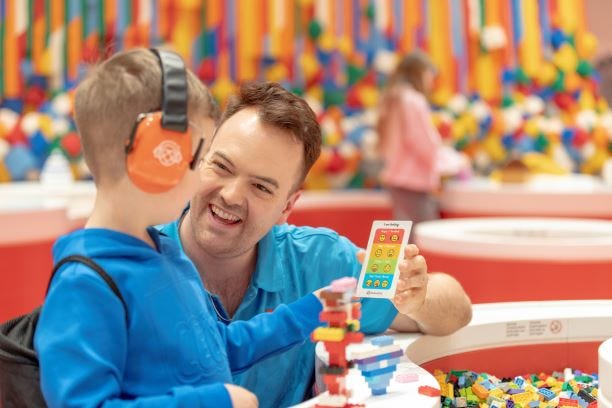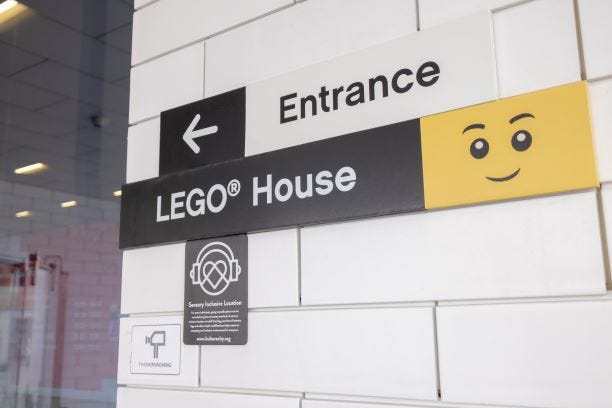

Autism Acceptance Month has arrived, and with it, many sensory inclusive events and shopping hours.
Many of those efforts fade by the end of the month, unfortunately. But LEGO, the world’s most successful toy company, has announced a long-term commitment “aimed at embracing neurodiversity and fostering inclusive experiences for all fans, especially children,” the company said in a news release on Tuesday, which is World Autism Day.
The Danish toy brand has partnered with KultureCity, a nonprofit that works to make venues more inclusive, to have all its stores in the U.S. and Canada “sensory certified” by the end of April, with plans to expand into more countries later in the year.
“We are truly honored in this partnership with LEGO to make all their retail stores sensory inclusive with a combination of staff training, sensory bags and app integration,” Julian Maha, co-founder of KultureCity, told USA TODAY.
“We love that this classic toy brand giant brings so much joy and now, inclusion, globally as they move forward in making the shopping experience accessible to all customers,” he said.
One day you will bake a cake:To the parents of a newly-diagnosed child on World Autism Day
What to expect at LEGO House, stores across the US and Canada

KultureCity requires at least 50% of staff at any certified LEGO store and the LEGO House to receive inclusion training, but the certification process is ongoing, Meg Raby Klinghoffer, a KultureCity sensory trainer and autistic person herself, told USA TODAY.
On top of providing trainings, KultureCity staff has created visual stories to help neurodivergent families before they even arrive at a LEGO site.
“We create a visual story on our free app that makes it so patrons entering LEGO (or any of the places certified) can prep ahead of any overstimulation or understimulation before ever entering the stores,” Klinghoffer said.
Each LEGO site will be equipped with sensory bags for its autistic guests, as well. Here’s what the bag includes:
- Noise-reducing headphones: To help reduce environmental noise for anyone experiencing auditory sensitivity
- Fidget tools: To help regulate feelings and support stimming (tools include wacky track snap, jelly string noodle and marble mesh)
- Visual Cue Cards: To support communication
- KultureCity Lanyard: That can be worn to inform staff of sensory needs
- Strobe-Reduction glasses: To make lights appear less bright and calmer for anyone experiencing visual sensitivity
KultureCity sensory bags at the LEGO House location doesn’t currently include the KultureCity lanyard. Visitors at the LEGO House have access to the Sunflower Lanyard, which is globally recognized and indicates an individual may need accommodations. KultureCity sensory bags at the LEGO House won’t have the strobe-reduction glasses either.
Colette Burke, chief commercial officer at the LEGO Group, said that the company hopes the changes “will have a positive impact and help embrace the diverse needs and strengths of fans globally.”
All three U.S. LEGOLAND Resorts became Certified Autism Centers last year, according to previous reporting by USA TODAY.
LEGOLAND parks now more autism-friendly:Here’s how and what guests can expect.
Other inclusion efforts at LEGO
LEGO Life Magazine will receive updates following an audit by inclusivity experts with Special Network that will help make the magazine “more welcoming for neurodivergent readers,” the company says.
So far, the group has suggested the following improvements that have been included in the latest edition (Issue 2 2024), according to the release:
- Numbering the boxes used in cartoons to make them easier to follow
- Ensuring consistent and meaningful use of visual symbols
- Planning content to suit varied abilities and interests
- Having consistency in placement of useful items, such as prompts for activity answers
Special Networks will ask children and families to provide feedback, as well. A summary of an initial audit is available here and families can sign up for news on the survey via the family newsletter at www.LEGO.com/magazine.
‘Love the Way You Think’ Creators
Autistic creators have come together to release a series of short films on the LEGO Group’s YouTube channel as an attempt to give exposure to neurodivergent minds. The series, “Love the Way You Think,” features work from:
- Casey “Remrov” Vormer, a pencil artist in Canada who creates hyper-realistic drawings
- Gaku, an artist and painter in Japan who creates super colorful and joyful works of art
- Allyson Gail, a U.S. LEGO creator who builds LEGO models of food – with faces
LEGO fans react to the experience

Most of the integration has already happened, Klinghoffer told USA TODAY. So customers have had a chance to experience the new inclusive spaces. Here’s what some of them had to say:
Isabella age 11 and autistic “When I’m in a crowded place or noisy area, I feel nervous. The [noise reducing] headphones really help well because it just cancels out most loud noises. It gives me a little bit less stress. If there’s someone really close to me and I feel like I’m really nervous, I’ll just pop a fidget out and just play with it to calm myself down.”
Samantha (mom to Isabella)“When I heard about this project, I just beamed. I was so excited. I’ve been waiting for this – to just be able to go to the store, where the employees understand, and the store is ready for my child. It’s exciting. Having KultureCity involved gives me so much confidence that my child will enjoy the experience and the sensory bags will make us come to the store more often.”
Sean, autistic AFOL (Adult Fan of LEGO play) “To have sensory bags in a LEGO store when I was a kid would’ve changed my whole perspective on the communities I could be a part of. Being able to experience the LEGO store at my own pace would have allowed me to connect to so many other people and LEGO fans, and truly feel like I belong. This move will allow for people like me, a full-grown adult, to experience everything the store has to offer and let children visiting the store have their own perspective on their own lives changed in a positive way. That’s something that can’t be replaced.






